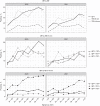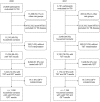Tuberculin skin testing and QuantiFERON™-TB Gold Plus positivity among household contacts in Vietnam
- PMID: 37736581
- PMCID: PMC10446657
- DOI: 10.5588/pha.23.0020
Tuberculin skin testing and QuantiFERON™-TB Gold Plus positivity among household contacts in Vietnam
Abstract
Setting: TB infection (TBI) is diagnosed using the technique-dependent tuberculin skin test (TST) or costly, more accurate interferon-gamma release assays. The TST (⩾10 mm) threshold was indicated by previous research among household contacts in Vietnam, but routine implementation with a different tuberculin reagent showed unexpectedly low TST positivity.
Objective: TST (⩾5 mm and ⩾10 mm) results were compared to QuantiFERON™-TB Gold Plus (QFT) results in household contacts during community campaigns in 2020 and 2021.
Design: This was a cross-sectional multi-center implementation study.
Results: Among 1,330 household contacts in 2020, we found a TBI prevalence of 38.6% (QFT), similar to TST ⩾5 mm (37.4%) and higher than TST ⩾10 mm (13.1%). QFT+/TST+ was higher for TST ⩾5 mm (20.7%) than TST ⩾10 mm (9.4%). QFT was not discordant with TST ⩾5 mm (McNemar's test = 0.6, P = 0.5) but was discordant with TST ⩾10 mm (McNemar's test = 263.9, P < 0.01). Older age and Southern region increased odds for positive TST ⩾5 mm and QFT with weaker associations for TST ⩾10 mm. Agreement and discordance were similar in 2021 for 1,158 household contacts.
Conclusion: Tuberculin reagents affect TST positivity rates. High TB burden countries should monitor reliability of TBI diagnosis, including tuberculin potency, cold chain, and TST technique to optimize eligibility for TB preventive treatment.
Contexte: L’infection tuberculeuse (TBI) est diagnostiquée à l’aide du test cutané à la tuberculine (TST), qui dépend de la technique, ou de tests de libération de l’interféron-gamma, coûteux et plus précis. Des recherches antérieures ont indiqué que le TST (⩾10 mm) est généralement utilisé pour diagnostiquer la TB parmi les contacts familiaux au Vietnam ; la mise en œuvre de routine avec un réactif de tuberculine différent a montré une faible positivité inattendue du TST.
Objectif: Les résultats du TST (⩾5 mm et ⩾10 mm) ont été comparés aux résultats de QuantiFERON™-TB Gold Plus (QFT) chez les contacts familiaux au cours des campagnes communautaires de 2020 et 2021.
Méthode: Il s’agissait d’une étude transversale multicentrique de mise en œuvre.
Résultats: Parmi 1 330 contacts familiaux en 2020, nous avons trouvé une prévalence de TBI de 38,6% (QFT), similaire au TST ⩾5 mm (37,4%) et plus élevée que le TST ⩾10 mm (13,1%). Le QFT+/TST+ était plus élevé pour le TST ⩾5 mm (20,7%) que pour le TST ⩾10 mm (9,4%). Le QFT n’était pas discordant avec le TST ≥5 mm (test de McNemar = 0,6 ; P = 0,5) mais était discordant avec le TST ⩾10 mm (test de McNemar = 263,9 ; P < 0,01). L’âge avancé et la région méridionale augmentaient les probabilités d’un TST positif ⩾5 mm et d’un QFT, avec des associations plus faibles pour un TST ⩾10 mm. La concordance et la discordance étaient similaires en 2021 pour 1 158 contacts familiaux.
Conclusion: Les réactifs de tuberculine affectent les taux de positivité des TST. Les pays à forte charge de TB doivent surveiller la fiabilité du diagnostic de TBI, y compris la puissance de la tuberculine, la chaîne du froid et la technique du TST afin d’optimiser l’éligibilité au traitement préventif de la TB.
Keywords: interferon-gamma release tests; latent tuberculosis infection; tuberculin tests.
© 2023 The Union.
Figures


References
-
- World Health Organization WHO consolidated guidelines on tuberculosis. Module 1: prevention - tuberculosis preventive treatment, 2020. Geneva, Switzerland: WHO; 2020. - PubMed
-
- Getahun H, et al. Latent Mycobacterium tuberculosis infection. N Engl J Med. 2015;372(22):2127–2135. - PubMed
-
- Paton NI, et al. Diagnosis and management of latent tuberculosis infection in Asia: Review of current status and challenges. Int J Infect Dis. 2019;87:21–29. - PubMed
LinkOut - more resources
Full Text Sources

